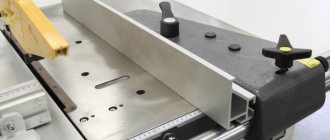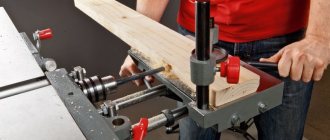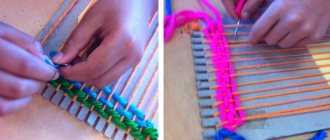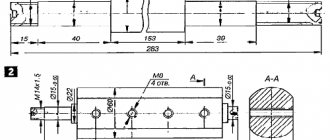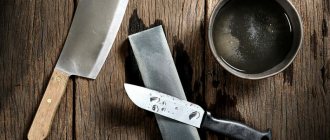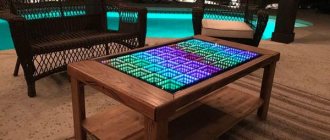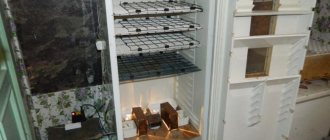Quick release rip fence for DIY machines
Hello, dear readers and DIYers!
One of the most important design features for many different machine tools is the rip fence. Without it, it is impossible to perform a number of basic operations on circular, milling and band saw machines.
Of course, this device almost always comes complete with factory machines, but some machines can be made independently, the same applies to the rip fence.
In this article, the author of the YouTube channel “Crazy Workshop” will tell you how he made a quick-release version of such an emphasis.
This project is fairly easy to make but will require a small amount of welding.
Materials. — Steel profile pipes 20X20 40X40 mm — Bakelite wing nut M8 — Sheet plywood 25 mm thick — Steel stud M8, nuts, washers, angles — Compression spring, self-tapping screws — Aerosol enamel, PVA glue, sandpaper.
A layer of PVA glue is applied to the profile pipe, and a plywood piece is screwed to it. In this case, the author uses self-tapping screws with a conical head for countersunk.
Of course, before gluing these elements, you need to clean the frame with a flap disc, degrease and paint it to protect it from corrosion.
By tightening this nut, the movable “sponge” will be pressed, and the entire structure of the stop will work like a kind of long clamp, fixing on the edges of the table.
Of course, both edges of the table must be parallel to each other.
Of course, it requires several improvements. For example, a movable clamp should be made with a 100-150 mm guide, cutting a 35X35 mm profile pipe, which will be inserted into the frame with virtually no play.
A 20X20 mm pipe should be welded to such a guide, similar to a fixed stop.
Thus, the parallel stop will be fixed on both sides of the table with wide “jaws”, which will reduce the deviation of the stop plane from an angle of 90 degrees relative to the edge of the table.
I thank the author for implementing a simple design of a quick-release rip fence for machine tools.
Good mood, good health, and interesting ideas to everyone!
The author's video can be found here.
Source
Classification and capabilities
The design of the units in question can be quite varied. Machines are classified according to the following criteria:
- By drive type. Homemade mini-devices can also have a manual drive, but in most cases they still use an electric drive. At the same time, household models are equipped with a 220 V motor, and professional ones – with a 380 V motor.
- By type of delivery. The machine design may have one or two pairs of feed rollers; accordingly, in the first case, it will be necessary to make the pressure of the workpiece being processed to the table more powerful; vibrations at the time of cutting cannot be excluded. Double-sided roller feeds are more advanced and convenient to use. A number of foreign companies (Makita, DeWalt, etc.) equip their products with automatic feed units, but this option is justified only with significant production programs of the same type of products.
- According to the number of knife shafts. This determines how many different profiles the machine can process simultaneously. True, the number of operators will increase accordingly.
- By functionality. The design of thicknessing machines allows not only dimensional processing of a semi-finished product, but also its subsequent calibration. This eliminates the appearance of transverse chips, dents and other defects that may appear on the treated surface in case of non-compliance with the jointing technology or with an excessively large supply of starting material.
- According to its technological characteristics. In practice, the equipment under consideration is produced with a power range of 1...40 kW, at a shaft speed of up to 10000...12000 min -1, planing width up to 1350 mm, stroke up to 50 m/min and thickness of the initial workpiece 5...160 mm.
Purpose of the clamping device for the machine
At first glance, modification of the woodworking machine is necessary only to fix the workpiece. However, with the correct choice of manufacturing scheme, the installed part can perform a number of other, no less important functions.
When processing wooden products, you can adjust their fixation manually. Ultimately, this affects the quality of the surface. This is especially true for thin strips, the thickness of which does not exceed 2-3 cm. Therefore, a do-it-yourself fixing device, after installation on the machine, should have the following functions:
Before starting design, it is recommended to familiarize yourself with similar factory models. To make the clamping mechanism with your own hands, scrap materials will be used. Therefore, when choosing the optimal design, it is necessary to be guided by the principle of expediency.
Experts do not recommend installing a fixing device for a jointer. This may affect the quality of the products.
Types of planing machines
Wood planer
The design of the clamping mechanism directly depends on the equipment model. Therefore, it is first necessary to carefully study the technical documentation, the features of the machine elements, and their characteristics.
The most common option is a power unit (electric motor) that drives a cylindrical cutter head. Its upper part is located above the level of the support table. The latter can move relative to the cutting part in the vertical direction. In this way, the depth of processing of the wooden workpiece is adjusted. You can make a similar model with your own hands.
In addition to the woodworking machine described above, the following types of equipment are used for mass production:
- thicknesser with one cutting head;
- cycle. Installed on lines for assembling furniture, door and window structures;
- two, three and tetrahedral. Processing occurs in several planes at once, which increases productivity;
- models with several knives.
Almost all modern equipment has clamps. The exceptions are machines made by yourself or old models.
When choosing a retainer design, you should pay attention to the equipment configuration. After its installation, the operational and technical qualities should not deteriorate.
Homemade clamp: option No. 1
Most often, for the manufacture of the above-described design, a part from an old washing machine is taken as a basis, and in particular, rollers for squeezing out moisture. In some cases, after minor modifications, the add-on can be installed on the equipment.
The frame consists of four support legs, which are connected to each other by a U-shaped profile. Locking shafts are installed on it. The profiles are not fixed to the base, but move freely along them. At the top of the structure there is a locking bar connected to the adjustment handle by a worm gear. For shock absorption, you can install springs that will partially compensate for the strong pressure when processing uneven surfaces.
The structure consists of the following components.
Using the top handle, you can adjust the degree of pressure. The disadvantage of this model is its large massiveness. It may not be suitable for all types of machines.
To reduce the labor intensity of manufacturing a mechanism for a planer, you can use the rollers of a washing machine. They need to be trimmed first.
Step-by-step manufacturing instructions
To make a household thicknessing machine, you need to prepare a workplace and perform the following steps:
- Attach a sheet of plywood to the side edges of the plane. Mark along the contour of the protective casing and cut out a template. It should go around the electric motor casing without gaps.
- Make a template of another shape in the same way.
- Transfer the contours of the templates onto 10 mm thick plywood sheets and cut them out. Then you need to make two strips 10x10 mm thick, which will subsequently serve as guides.
- Make holding crossbars from a block. They should fit as tightly as possible to the front and back parts of the electric planer handle.
- Using a milling machine or jigsaw, cut out longitudinal grooves according to the previously applied markings. In the future, they will be necessary to adjust the thickness of the planing.
- By passing the crossbar under the back of the electric planer handle, connect the cut out parts. To fix the jumper, it is better to use screws with a countersunk head.
- Attach the slats prepared in advance to the back side of the workpiece and apply markings on them. Then you need to trim them according to the applied markings.
- For further fastening of the workpieces to each other, a through hole for bolts is drilled in the upper part. In the same place, using a cutter, a hole 4 mm deep is made. Then the fastening nuts are hammered into it with a hammer.
- Having combined both blanks, they must be fastened using bolts with pressed wooden washers. As an alternative, wing bolts can be used.
- Make a hole in a wooden block to install a guide pin into it. For secure fixation, it is better to use a lock nut.
- Install a block with a guide pin in the front part of the future machine. Secure it with countersunk screws.
- Assemble the outer frame in the same way as the inner one. Place a wing nut on the guide pin to adjust the position.
- Make a guide sheet. To do this, use a chisel or milling machine to make rounded grooves in wooden blocks, the diameter of which will correspond to the diameter of the guide pipes, and install them as shown in the picture below.
- Prepare your desktop. It consists of a sheet of plywood 10 mm thick. Stoppers are installed along the edges, on which the guide rails will subsequently be fixed.
- The guide pipes must be connected to each other using plywood strips and the vacuum cleaner pipe must be connected. After this you can start working.
After watching the video, you can get acquainted with the nuances of manufacturing a thickness planer, as well as see its practical application.
Homemade clamp: option No. 2
An alternative option for making a machine clamp with your own hands is a slight modification of the equipment. It consists of installing two slats on the sides of the frame. Two bearings are installed in the main working shaft, through which a fixing axis passes.
The difficulty may lie in the configuration of the bed. All models have smooth edges to allow mounting of eyelets. The degree of clamping is adjusted using a spring. It moves along the slats, thereby changing the pressure on the workpiece.
How to make a simple thicknesser for wood with your own hands - step-by-step diagram
Step 1: Creating the Thicknesser Base
In the center of a T-shaped metal part measuring 3.5 * 7 cm, use a drill to carefully drill a hole with a diameter of 0.8 cm, then solder a tube into it, the outer diameter of which should be 1.6 cm, and the inner diameter, respectively , 0.8 cm. Thus, we will create a through channel for sliding the rod.
Step 2: Hairpin or Pencil Clip
We attach a ring clamp to one ring of the tube, which will serve as a mount for a pencil - for applying markings. At the other end we make a hole with a diameter of 0.6 cm with a thread for installing a thumbscrew. Its main task is to fix the rod in the required position. At the end of the rod where the clamp is attached, we install a soldered ring, which we equip with a clamping screw.
Step 3: Working on the Replacement Rod and Base
Our next step is to create a replacement rod in which we create several holes. One of them will be through - a hole with a diameter of 0.3 cm is drilled in it, the second hole is intended for installing locking screws 0.6 cm (M4 thread). In two places we drill a T-shaped part with an M4 thread. We will install a corrugated screw here, which will allow the tool to be used as a compass.
Homemade jointing machine: sketch, main manufacturing stages
For any work to be successful, you must have good equipment and tools. The same statement applies to amateurs (or professionals) “tinkering” with wood. Craftsmen who make furniture or other wooden products always try to acquire various tools and devices that can help them in their work.
For example, a jointer. This device significantly increases the productivity and quality of woodworking. But not all fans can purchase it, because its price is quite high. How to get out of such a difficult situation? There is a solution, and it’s quite simple - it’s to make a tabletop jointer with your own hands. And the manufacturing process itself will be discussed in the article.
How to make a thickness planer for wood at home
If necessary, such a machine can be made at home. This does not require the use of special equipment or special technical skills.
The simplest machine can be made by fixing the plane on the table in a sideways or upside-down position. More advanced models require more time and effort.
What is needed for making
To make a homemade thicknesser, you need a minimum set of materials and tools, which are often in the arsenal of every owner. It includes:
- electric plane;
- jigsaw;
- metal sheet 0.5 mm thick;
- laminated chipboard sheet;
- metal pipe;
- hand drill;
- set of drills for wood and metal;
- fastening hardware;
- set of wrenches.
Which plane to choose for this purpose?
The electric plane is the main working part of the machine. Therefore, before starting assembly, it is necessary to select a tool with optimal parameters. The main technical characteristics that should be taken into account when choosing a plane are:
- planing width. Most modern electric planers are equipped with a support sole and blades 82 mm wide. This is quite enough for household work;
- electric motor power. To carry out high-quality planing of workpieces, it is best to use planes with an electric motor power of 800 W or more. This will allow for high-quality planing;
- blade rotation speed . There is a direct relationship between the number of revolutions of the knife block and the quality of planing. In other words, the more revolutions the blades make, the cleaner the processed surface is.
The best choice for making a thickness planer would be the following tools:
- RESANTA P82/800;
- DIOLD RE-1100-01;
- INTERSKOL R82/710.
Why do you need a jointer?
A woodworking shop can have a variety of machines, but the most commonly used (besides the circular saw, of course) are jointers and planers. These two types of units are slightly similar in their function, but differ in the method of use.
Thicknessing machines are available in both single-sided and double-sided types. In the first case, only one side of the workpiece is processed in one pass. A double-sided thickness planer is more productive. Here the output is an almost finished part.
Thicknessing machines have a shaft located above the tabletop. Moreover, the latter is made massive in order to smooth out large vibrations. In addition, the mechanism is equipped with a special casing, which is designed to dampen noise.
A jointer has a slightly different task. This device is used to create a smooth surface without significant roughness on the workpiece. This machine, like the previous version, is equipped with a shaft with knives, only in the jointer it is located under the table top.
The workpiece is fed onto the work surface from one side, and the output from the opposite side is already partially processed. This way, layer by layer, the desired evenness is achieved. After processing on a jointer, the part can be fed to a surface planer.
Manufacturing
For work you need to use the following materials and tools:
- Electric planer or motor, depending on the chosen design option.
- Plywood 10-15 mm thick for tables and 15-20 mm for making the side wall of the bed, which will serve as the basis of the structure. For manufacturing, you can use chipboard, but such a jointing machine will be less convenient.
- Drill with drill bits of suitable thickness.
- Jigsaw.
- A circular saw.
- Electric screwdriver.
- A wooden board or timber for making a side support.
Making a jointer from an electric planer is easier than using a separate motor, but the latter will be less powerful. Before starting work, you need to select a suitable design and make a drawing.
We make the bed
It is the basis of the entire structure. All other parts are attached to it. When making it yourself, it is convenient to use a sheet of plywood of a suitable size for this purpose.
The frame must ensure high structural stability. All parts must be securely attached to it. The method of attachment depends on the material used. For metal parts, you can use welding or screw fastenings; for wooden parts, screws and glue. When choosing a frame option, you need to consider whether you plan to make the structure collapsible. In this case, it is more convenient to use screw connections.
Installation of the blade shaft
You won’t be able to make a shaft for a jointer yourself. It is better to order this unit from specialists or purchase it in a store. The saw consists of three blades, which, when rotated, remove a layer of wood from the workpiece.
The drum is mounted on the frame using bearings. A roller must be provided at the edge of the shaft on which a belt connected to the motor shaft will be attached.
Table
The design provides two tables for the jointer - receiving and feeding. They are located on both sides of the shaft with knives. The surface must be smooth, because the workpiece must be pressed against the surface during processing.
In order for the processing to be of high quality, the height of the tabletop surface must correspond to the blades. The lower it is, the greater the layer of wood that will be removed during processing. To adjust the height of the table, a special mechanism is installed.
Motor Drive Installation
To make an electric jointer, you need to choose the right electric motor. It is enough for its power to exceed 1000 W. It is convenient to use models that are powered by 220 V.
The pulleys of the engine and drum with knives must be in the same plane. In order to achieve this, it is necessary to use special tools (level and other measuring tools). In this case, the belt will transmit rotation in the most efficient way.
The belt must be tight. Otherwise, it will not be able to provide the required rotation speed. When providing space for the engine, it is necessary that it be possible to adjust its position. In this case, it will be convenient to select it so as to ensure the desired degree of pulley tension.
Hard stop
It is necessary to install a wooden piece perpendicular to the surface of the table, which will serve as a guide. It is needed in order to ensure the linear movement of the workpiece. To do this, you can use a wooden piece of a suitable shape. In this case, it is necessary to clean its surface so that there are no burrs or irregularities on it.
Basic Concepts
Such equipment will have numerous rotating parts. From this we can conclude that making such a machine with your own hands will not be so easy. Therefore, when starting to manufacture it, you need to calculate your strength. If you already have some similar experience, then you will cope with the task. It is worth noting right away that you will not be able to make a jointing machine entirely from parts of your own making. Of course, it’s possible that you have a large assortment of different devices in your “bins,” but this rarely happens. First of all, this concerns the shaft with knives and bearings. They will most likely have to be purchased or even ordered. But if everything you need is available, then you can safely start designing.
Preparing for work - setting up and using the tool
It doesn’t matter whether you purchased the tool or whether you made the thicknesser yourself, you need to know how to properly prepare the device for work. The effectiveness of the tool itself and your safety when working with a thickness planer will depend on this. Despite the fact that the external and practical difference between expensive and cheap models is significant, their work is carried out according to the same principle. A block with a pin, a pencil or several knives for marking grooves slides inside the block. It, in turn, is equipped with a special mechanism for holding the bar or metal in the required position.
In order to get narrow and at the same time uniform lines, the pins or thicknesser knives must be very sharp. Most factory models are usually equipped with conical parts that leave an uneven mark when marking across the wood grain. That is why work should be carried out not across, but along the fibers. To achieve the best results, it is necessary to sharpen the studs sharply and equally before each marking step.
Electric drive of the jointer
And of course, don’t forget about the drive. All mechanisms must rotate. This means that the drive will be the “heart” of the machine. Here are some recommendations for this design element: - first of all, prepare the electric motor.
Electric motor for jointer
It is best to use a three-phase unit for these purposes. Of course, in this case you may have to redo the electrical network in your workshop, but it will be worth it. Three-phase electric motors operating at a voltage of 380 V are capable of developing greater power. In addition, the torque of such devices is suitable for our purposes. The minimum power value should be 3 kW, but the maximum is at your discretion;
Be very careful about providing power to the machine. Three-phase current is supplied through a four-core cable. In this case, reliable grounding must be organized. These requirements will help avoid accidents when working on the machine.
Making a simple thicknesser for wood with your own hands
Many people think that making a surface planer on their own is not so profitable, since they will have to spend money on purchasing parts, materials, and spend time creating the device. However, everything is not so obvious, since economy-class tools are much worse in quality and are not as reliable as devices that are made at home.
Moreover, a thicknesser can be used in many construction areas: when working with wooden products, metal, for transferring drawings to future workpieces, in a variety of carpentry works.
To do this, we will need brass solder, 4 mm taps, various screws, and a T-shaped metal blank. Tools that will be useful are a soldering iron, an electric drill to speed up work, and dies. We also attach a drawing of the thicknesser for clarity.
Drawing. The main stages of creating a jointer
Tabletop jointer - drawing
Tabletop jointing machine - drawing (part 2)
A jointing machine, its simplest version without additional functions, can be made quite easily with your own hands. The general progress of work in this case will look like this:
When fastening, glue and clamp are used. The recess should ideally fit the dimensions of the bearing;
After creating the system for turning the electric motor on and off, the machine is ready for use. But in order for your new tool to bring only benefit and joy to work, it is worth using it correctly and safely.
Design and operation scheme
The thickness planer consists of the following main parts:
- a horizontal table for processing various wooden parts and products (or a base made of a sheet of plywood, as in the homemade version);
- working processing knife shaft. One - in a single-sided design and two - in a double-sided design;
- pressure rollers responsible for feeding the part to the knife shaft;
- platform adjusting the height of the table;
- a fuse that prevents the workpiece from falling out of the machine. There is a risk of falling out if parts of different thicknesses are processed. In this case, a product of smaller thickness will hit the knife and jump out of the machine. To prevent this from happening, a special safety device is installed.
It all works like this: when the electric planer is turned on, it begins to rotate the blade shaft. The wooden part is placed in the gap and fed first to the lower and then to the upper rollers. The upper front roller is corrugated. Due to this, it grabs the part and transfers it to the knife shaft. In this case, the guides securely fix the workpiece and prevent it from falling out. After the product moves from the rear guide, the next workpiece is transferred to the front. And so on until all the details are processed.
